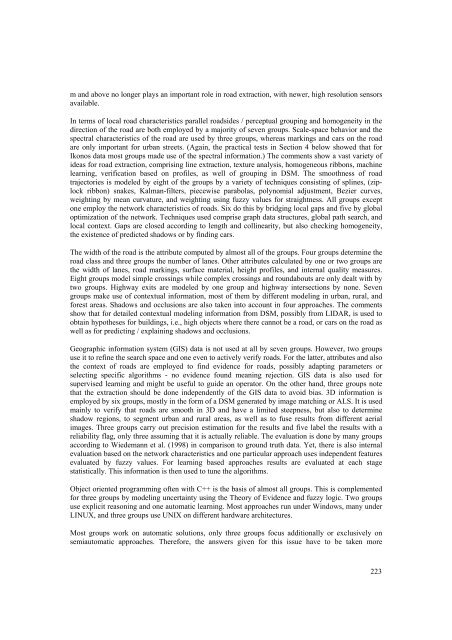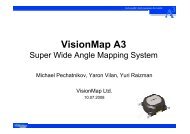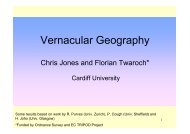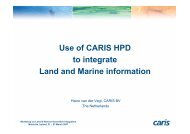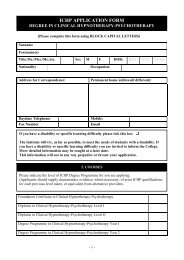EuroSDR Projects - Host Ireland
EuroSDR Projects - Host Ireland
EuroSDR Projects - Host Ireland
Create successful ePaper yourself
Turn your PDF publications into a flip-book with our unique Google optimized e-Paper software.
m and above no longer plays an important role in road extraction, with newer, high resolution sensors<br />
available.<br />
In terms of local road characteristics parallel roadsides / perceptual grouping and homogeneity in the<br />
direction of the road are both employed by a majority of seven groups. Scale-space behavior and the<br />
spectral characteristics of the road are used by three groups, whereas markings and cars on the road<br />
are only important for urban streets. (Again, the practical tests in Section 4 below showed that for<br />
Ikonos data most groups made use of the spectral information.) The comments show a vast variety of<br />
ideas for road extraction, comprising line extraction, texture analysis, homogeneous ribbons, machine<br />
learning, verification based on profiles, as well of grouping in DSM. The smoothness of road<br />
trajectories is modeled by eight of the groups by a variety of techniques consisting of splines, (ziplock<br />
ribbon) snakes, Kalman-filters, piecewise parabolas, polynomial adjustment, Bezier curves,<br />
weighting by mean curvature, and weighting using fuzzy values for straightness. All groups except<br />
one employ the network characteristics of roads. Six do this by bridging local gaps and five by global<br />
optimization of the network. Techniques used comprise graph data structures, global path search, and<br />
local context. Gaps are closed according to length and collinearity, but also checking homogeneity,<br />
the existence of predicted shadows or by finding cars.<br />
The width of the road is the attribute computed by almost all of the groups. Four groups determine the<br />
road class and three groups the number of lanes. Other attributes calculated by one or two groups are<br />
the width of lanes, road markings, surface material, height profiles, and internal quality measures.<br />
Eight groups model simple crossings while complex crossings and roundabouts are only dealt with by<br />
two groups. Highway exits are modeled by one group and highway intersections by none. Seven<br />
groups make use of contextual information, most of them by different modeling in urban, rural, and<br />
forest areas. Shadows and occlusions are also taken into account in four approaches. The comments<br />
show that for detailed contextual modeling information from DSM, possibly from LIDAR, is used to<br />
obtain hypotheses for buildings, i.e., high objects where there cannot be a road, or cars on the road as<br />
well as for predicting / explaining shadows and occlusions.<br />
Geographic information system (GIS) data is not used at all by seven groups. However, two groups<br />
use it to refine the search space and one even to actively verify roads. For the latter, attributes and also<br />
the context of roads are employed to find evidence for roads, possibly adapting parameters or<br />
selecting specific algorithms - no evidence found meaning rejection. GIS data is also used for<br />
supervised learning and might be useful to guide an operator. On the other hand, three groups note<br />
that the extraction should be done independently of the GIS data to avoid bias. 3D information is<br />
employed by six groups, mostly in the form of a DSM generated by image matching or ALS. It is used<br />
mainly to verify that roads are smooth in 3D and have a limited steepness, but also to determine<br />
shadow regions, to segment urban and rural areas, as well as to fuse results from different aerial<br />
images. Three groups carry out precision estimation for the results and five label the results with a<br />
reliability flag, only three assuming that it is actually reliable. The evaluation is done by many groups<br />
according to Wiedemann et al. (1998) in comparison to ground truth data. Yet, there is also internal<br />
evaluation based on the network characteristics and one particular approach uses independent features<br />
evaluated by fuzzy values. For learning based approaches results are evaluated at each stage<br />
statistically. This information is then used to tune the algorithms.<br />
Object oriented programming often with C++ is the basis of almost all groups. This is complemented<br />
for three groups by modeling uncertainty using the Theory of Evidence and fuzzy logic. Two groups<br />
use explicit reasoning and one automatic learning. Most approaches run under Windows, many under<br />
LINUX, and three groups use UNIX on different hardware architectures.<br />
Most groups work on automatic solutions, only three groups focus additionally or exclusively on<br />
semiautomatic approaches. Therefore, the answers given for this issue have to be taken more<br />
223


